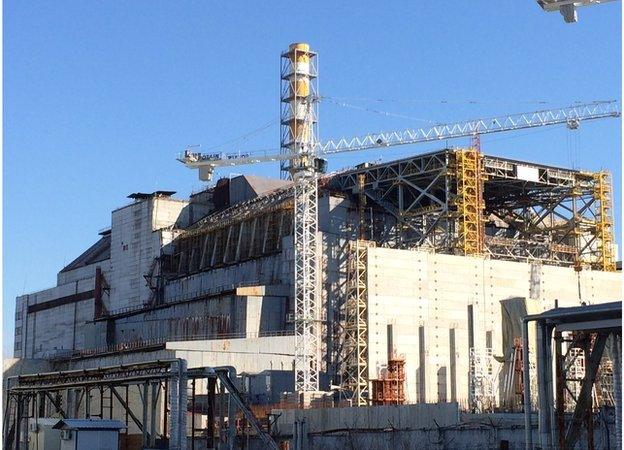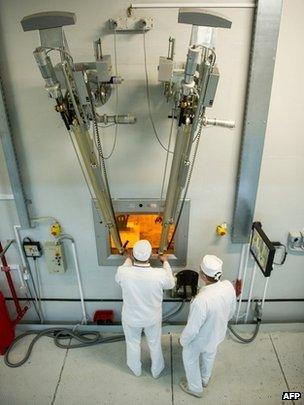Chernobyl: Containing the world's worst nuclear accident
- Published
- comments
David Shukman explains how the protective shield works and how it will be moved into place
Rising above the scene of the world’s worst nuclear accident is the spectacular sight of the largest moveable structure ever created on land.
The complex of nuclear power plants at Chernobyl has dominated this corner of northwest Ukraine for decades but the new construction towers over it all.
The project is to build what is called a New Safe Confinement – in effect, a giant cover, a kind of dome, to fit over the building that houses the reactor that exploded on 26 April, 1986.
The radiation immediately above the reactor is still far too intense for the new enclosure to be built exactly where it is needed – anyone working there can only stay very briefly.
So adjacent land has been cleared and then decontaminated – a massive task in itself – to allow the new structure to be assembled before being manoeuvred into position.
Sealed future
Large enough to accommodate a couple of Boeing 747s or the Stade de France in Paris, and almost tall enough to hold St Paul’s Cathedral in London, the giant cover stands on a system of massive rails.
When complete, it will weigh an extraordinary 31,000 tonnes.
Over several days, it will be rolled along its special track so as to just slide over the reactor building – a very tight fit – in order to seal it in.

There is still a 30km exclusion zone around the Chernobyl site
The task is “of a complexity and uniqueness we have never faced before”, according to Vince Novak, who runs the nuclear safety department of the European Bank for Reconstruction and Development. He has led the international drive to make Chernobyl less dangerous.
“Until this project is in place, we will not be safe,” he said during a media visit to the site.
“The ultimate objective is to protect the environment, contain the threat and deal with the radioactive material inside.”
Dangerous mix
This material is a nightmare mix of more than 100 tonnes of uranium, one tonne of plutonium, and other highly radioactive elements, formed into a previously-unseen lava-like mass.
Added to that are several thousand tonnes of sand and boron dropped on to the site by emergency workers at the time.
Vast quantities of radioactive liquids and dust are also present inside a reactor building that has itself long been in danger of collapse.
In the months following the accident – when the reactor exploded and burned for 10 days – the authorities attempted to smother the building in an emergency “sarcophagus” of concrete and steel.
But this was only ever intended to be a temporary fix and has needed urgent repairs to try to keep it stable and intact.

The arch is being assembled in two halves in an area about 300m to the west of the sarcophagus, to protect workers from high levels of radiation. The project is due to be fully commissioned by November 2017

The assembly area has been filled to a depth of 1m and partially covered in concrete slabs to provide extra protection from radiation. The arch is built on the ground, where radiation levels are lowest, and then lifted using cranes.

The structure will have a complex ventilation system to control the atmosphere inside the arch. It is also equipped with overhead bridge cranes designed for dismantling the existing shelter and damaged reactor.

The finished structure will weigh about 31,000 tonnes and stand 110m tall and 257m wide. It must be capable of withstanding temperatures ranging from -43C to 45C and has a predicted life span of 100 years.
One of the shift managers working at the power station back in 1986 – though not on duty when the disaster struck – told me how that weakness of the building is a serious concern.
According to Lenar Sagidulin, the emergency concrete was “just stuck to the side of the building; it was not stable.
“All this structure could just collapse, suddenly. There are cracks and holes growing in size, so this new confinement is a good idea and will meet its intended functions.”
The confinement system involves some seriously challenging engineering – it’s designed to withstand a magnitude 6 earthquake, a Category 3 tornado and temperature extremes ranging from -43C to +45C.
A double skin creates a cavity between the inner and outer walls that helps regulate temperature and humidity, and a complex ventilation system uses a system of negative pressure to keep any radioactive dust trapped inside.

The reactor building itself is unsafe and is at risk of collapse
The goal is not merely to enclose the damaged reactor and isolate it from the corrosive effects of the weather - but also to create a space in which to start the job of dismantling the most hazardous components.
Suspended from the apex of the structure will be remotely operated cranes, designed to tackle tasks too hazardous for human beings.
During the assembly phase, the radiation risk has been minimised by the construction of a protective wall right beside the reactor building.
This means the workforce at the assembly site receive minimal doses of radiation.
The man in charge of the project’s management, Ron Hink, joked that he probably gets a higher dose while flying home to Kentucky.
But he acknowledges a greater risk during a crucial stage of the forthcoming operation to install the new structure.
Donor gap
Although the walls at each end have been shaped to fit over the contours of the reactor building’s roof, teams of workers will still need to be on hand to make sure of a tight seal.

Work continues at the Chernobyl site to deal with the radioactive waste
Mr Hink said: “That’s probably the most hazardous job we have here. That work is inside the structure and that is fairly high-dose and will require a lot of workers to execute.
“They will work on a 15-on, 15-off rotation so they will only work half the month.”
Coming up with the design has involved a long and difficult journey. Initially, Russian experts favoured smothering the whole building in a massive tomb of concrete – until the risks of corrosion and cracking were highlighted.
Then came the task of raising funds for such an expensive project – currently priced at 1.5bn euros for the confinement system, with a total bill for repair and safety work at the site of 2.15bn.
As things stand, the EBRD has committed 675m euros, with the European Commission providing 361m. The third largest donor is the United States with 241m. Ahead of a donors' conference next month, there are concerns about meeting a shortfall in funding. The hope is that existing pledges by the EBRD, the European Commission and G7 nations to cover most of a 615m euros shortfall will be confirmed, with a further 100m euros needed from non-G7 countries.
The intention is to have the new structure in place and fully commissioned by November 2017.
If that is achieved, it would be 31 years since the disaster itself – but should provide protection for at least a century.

The size of the building can only really be conveyed using a very wide-angle lens